Optimizing Energy Consumption in Smart Buildings through Big Data and Machine Learning
Authors :
Ms. T. Ummal Sariba Begum
Address :
RESEARCH SCHOLAR, SRM INSTITUTE OF SCIENCE AND TECHNOLOGY, RAMAPURAM, CHENNAI, ummal@srm.edu.in
Abstract :
The efficient management of energy usage in intelligent buildings presents a significant obstacle within sustainable infrastructure, requiring inventive approaches to tackle increasing energy requirements and environmental issues. Although Internet of Things (IoT) strategies produce a huge quantity of data in these structures, it is still challenging to extract practical insights for effective energy management. This study utilizes machine learning approaches, namely Long Short-Term Memory to Optimize Energy Consumption (LSTM-OEC), to tackle these difficulties in smart buildings using big data analytics. The suggested methodology combines historical energy usage data with real-time sensor information from IoT devices, driven by the need to cut energy expenses and decrease carbon emissions. Utilizing the LSTM-OEC model facilitates the integration of intricate temporal relationships and precise prediction of forthcoming energy requirements, hence facilitating the dynamic optimization of building energy systemsThe primary objectives of this research effort are to develop a preliminary energy management framework employing Long Short-Term Memory (LSTM) models, assess its effectiveness in reducing energy consumption, and examine its potential for scalability and suitability in real-world smart building environments. LSTM networks are selected because they can effectively process sequential data and acquire knowledge of long-term relationships. This characteristic renders them exceptionally well-suited for time-series projection tasks, such as the prediction of energy use. The work showcases the effectiveness of LSTM-based energy management systems in generating substantial savings in energy usage while ensuring occupant comfort levels through thorough testing and validation. The study results indicate that the LSTM-OEC model consistently performs better than conventional forecasting techniques, offering more precise projections of forthcoming energy demand. Furthermore, the findings of the study indicate that the suggested approach presents a viable and flexible resolution for enhancing energy efficiency in intelligent structures, hence facilitating the advancement of sustainable infrastructure.
Keywords :
Energy consumption; Smart buildings; Sustainable infrastructure; Internet of Things; Machine learning techniques; Long Short-Term Memory; Big data analytics
1.Introduction
The efficient management of energy usage in intelligent buildings has become a significant obstacle to sustainable infrastructure advancement [1]. Given the escalating energy demand and mounting environmental apprehensions, there exists a pressing want for inventive approaches to augment energy efficiency and alleviate the ecological impact of contemporary structures [2]. Intelligent buildings with a wide range of Internet of Things (IoT) devices present a distinct potential to utilize data-driven methodologies to enhance energy efficiency [3]. Nevertheless, deriving practical and valuable information from the vast volumes of data produced by these Internet of Things (IoT) devices poses a significant challenge in achieving effective energy management [4]. This study aims to investigate and utilize machine learning techniques, specifically LSTM neural networks [5], to enhance energy efficiency in smart buildings using big data analytics [6]. In the present context, the application of machine learning presents the potential to extract significant insights from the extensive data present in smart building environments, therefore facilitating the development of more efficient energy management techniques [7].
The rationale for doing this research arises from the necessity to mitigate energy expenses and decrease carbon emissions linked to building activities. With the growing recognition of sustainability's significance by the worldwide population, there is an urgent requirement to create inventive solutions that enhance energy efficiency and aid in environmental conservation [8]. The suggested LSTM-OEC approach combines past energy consumption data with up-to-date sensor data obtained from Internet of Things (IoT) devices placed in intelligent buildings [9]. The study aims to effectively estimate future energy consumption by utilizing the LSTM model [10], a particular type of recurrent neural network known for its capacity to grasp long-term relationships in sequential data. LSTM-based predictions can improve energy efficiency and enable proactive energy management methods by dynamically optimizing building energy systems [11].
This research aims to achieve three main objectives: firstly, to create a predictive energy management framework that utilizes LSTM models to forecast energy consumption patterns; secondly, to assess the effectiveness of this framework in optimizing energy consumption in smart building environments; and thirdly, to evaluate its scalability and applicability in real-world scenarios [12]. Pursuing these aims, the study intends to offer significant perspectives on the capacity of machine learning-based energy management systems to transform sustainable infrastructure development. LSTM networks [13] are highly suitable for the given task owing to their innate capacity to process sequential data and acquire complex temporal relationships. This characteristic renders them well-suited for time series forecasting tasks, such as predicting energy consumption, where past patterns are essential in shaping future projections [14]. The project aims to address the constraints of conventional forecasting approaches and enhance the accuracy and reliability of future energy demand predictions by utilizing LSTM models [15].
Through thorough experimentation and validation, the study seeks to showcase the effectiveness of LSTM-based energy management systems in achieving substantial reductions in energy consumption while ensuring occupant comfort levels. The study's primary outcomes demonstrate the LSTM-OEC model's superiority over conventional forecasting methods [16], underscoring its capacity to transform energy management strategies in intelligent buildings. Moreover, the findings of the study highlight the potential for the proposed technique to be easily expanded and adjusted, thereby facilitating its widespread use in the pursuit of sustainable infrastructure development. This study signifies a notable advancement in enhancing energy efficiency in intelligent buildings by combining big data analytics [17] and machine learning techniques [18]. The study aims to utilize LSTM neural networks [19] to provide building managers and stakeholders with practical insights that can contribute to the advancement of a sustainable and energy-efficient future.
The key contributions of this study are
- To develop a predictive energy management framework using LSTM models to forecast future energy demands in smart buildings, enabling proactive energy management and occupant comfort.
- To assess the efficiency of a suggested energy management framework in intelligent building settings, showcasing the effectiveness of LSTM-based systems in decreasing energy usage and delivering precise forecasts of future energy requirements, emphasizing the possibilities of machine learning-based approaches.
- To examine the scalability and applicability of the LSTM-based energy management framework in real-world smart building environments, providing insights for widespread adoption and laying the groundwork for sustainable infrastructure development practices.
This paper is organized in the following manner: Section 2 provides an overview of the current body of investigation in the literature. Section 3 provides a comprehensive description of the proposed system and its design. Section 4 examines the experimental findings and provides a detailed analysis. Lastly, section 5 of the study finishes with a concise overview of the findings.
2. Research Methodology
The prioritization of optimizing energy usage in smart buildings has become imperative due to the pursuit of sustainable infrastructure. There has been significant interest in the utilization of machine learning methods for regulating energy in smart buildings, mostly because of its ability to analyze large datasets and derive practical insights. The purpose of this systematic review is to synthesize and analyze previous research that has explored the application of machine learning techniques in improving energy efficiency inside intelligent buildings. The comprehensive research extensively analyzes various machine-learning techniques for predicting energy use in intelligent buildings. The research assesses the effectiveness of regression models, neural networks, ensemble approaches, and other algorithms in accurately predicting energy consumption trends [20]. It investigated the utilization of Support Vector Machines (SVM) in forecasting energy usage in intelligent structures. By examining past energy consumption data and environmental variables, SVM models exhibit encouraging outcomes in precisely predicting forthcoming energy requirements, hence assisting in implementing proactive energy management techniques [21]. A study suggested utilizing reinforcement learning to enhance the control of HVAC systems in intelligent buildings.
The model is capable of dynamically adjusting HVAC settings to decrease energy consumption and maintain interior comfort levels by acquiring optimal control policies through interactions with the building environment [22]. The current research examined the application of machine learning techniques in the domain of predictive maintenance within intelligent commercial structures. The utilization of sensor information and equipment indicators of performance in predictive maintenance models enables the detection of issues or inefficiencies. It allows proactive maintenance measures to minimize energy waste and enhance system reliability [23]. A study examined the application of unsupervised learning methods, specifically clustering and autoencoders, in the context of anomaly detection inside smart building devices. Unsupervised learning algorithms are crucial in detecting malfunctions, inefficiencies, or security breaches in building operations by identifying anomalous energy consumption patterns or system behaviors [24]. The study presented a reinforcement learning-based demand response system aimed at improving conservation of energy in smart buildings. The model demonstrates the ability to adapt energy use according to changing power costs, demand signals, and environmental factors, aiming to optimize energy conservation while ensuring the comfort of occupants [25]. Genetic algorithms are employed in research to optimize lighting control strategies within smart buildings. Determining appropriate lighting schedules to minimize energy consumption while maintaining adequate illumination levels is achieved using genetic algorithms, which consider several parameters like occupancy patterns, natural lighting conditions, and energy efficiency objectives [26]. A hybrid forecasting model was built in the study, which integrates machine learning algorithms and conventional time series analysis approaches to anticipate energy usage in smart buildings. The hybrid model enhances prediction accuracy and robustness by combining the advantages of various approaches [27]. The study investigated the utilization of ensemble learning methodologies, specifically Random Forests and Gradient Boosting Machines, in the context of energy optimization inside intelligent buildings. Ensemble learning improves prediction accuracy and robustness to uncertainty by integrating several models, enabling the development of effective energy management methods [28]. The aforementioned research underscore the importance of utilizing machine learning methodologies to augment energy conservation in smart buildings. Researchers can use data-driven methodologies to create inventive solutions that improve energy efficiency, decrease expenses, and contribute to sustainable building operations.
Multiple research gaps exist in the current body of literature about optimizing energy usage in smart buildings through machine learning techniques. Numerous research primarily concentrates on utilizing historical data to forecast energy consumption. However, they neglect to include the influence of real-time environmental conditions and occupant behaviors that could potentially affect energy usage. Certain methodologies may exhibit limited scalability when applied to extensive building portfolios or a wide range of building types, constraining their practicality in real-world contexts. Although short-term predictions can be precise, the long-term efficiency and ability to adjust to evolving circumstances are sometimes disregarded. The proposed LSTM-OEC model addresses the shortcomings of utilizing LSTM networks to capture temporal relationships in energy consumption data. Additionally, the model integrates real-time sensor information to enable dynamic optimization. This model provides precise and reliable long-term forecasts and can be easily expanded to accommodate different types of buildings. It is well-suited for practical implementation in smart building settings.
3. Proposed Method
The study's methodology presents a comprehensive framework for enhancing energy utilization in smart buildings through the use of the LSTM-OEC model. The objective of this model is to utilize the functionalities of LSTM networks, a distinct category of recurrent neural networks, in order to dynamically optimize energy consumption. The architecture and workflow of the LSTM-OEC model have been carefully designed to optimize its ability to capture intricate temporal correlations and adapt to dynamic environmental conditions in real time.
The architectural framework of the LSTM-OEC model seen in Figure 1 has several layers, each designed to serve a distinct function in the energy optimization process. Commencing with the input layer, which receives preprocessed data on past energy usage and current sensor readings, the model advances through LSTM layers designed to acquire knowledge of long-term relationships in sequential data. Stacked thick layers are employed to facilitate the processing of features and the creation of predictions. The output layer generates the estimates of future energy use, utilizing the acquired patterns and input data. In addition, the LSTM-OEC model is subjected to thorough training, validation, and testing stages to guarantee its precision and ability to generalize. Upon deployment, it consistently monitors sensor data in real-time to dynamically modify building systems, reducing energy usage while ensuring occupant comfort. The LSTM-OEC model's iterative nature enables it to adapt and improve its predictions over time, leading to a robust and scalable solution for managing renewable energy sources in intelligent buildings.
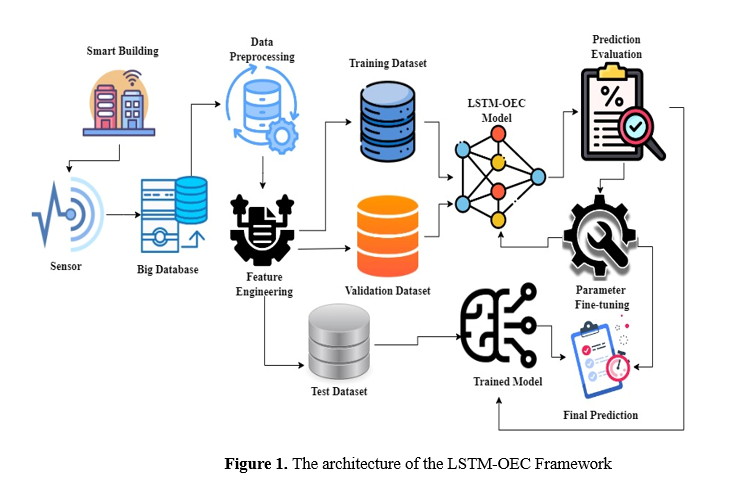
a. Data Collection and Preprocessing
The first stage of the methodology focuses on thorough data collecting and preparation methods to guarantee the precision and effectiveness of the LSTM-OEC strategy. Historical energy usage data is systematically collected for various smart building systems, including HVAC, lighting, and appliances. Furthermore, real-time sensor data streams are collected with great attention to detail, including several variables such as temperature, humidity, occupancy patterns, and exterior weather conditions. Following this, the gathered data is subjected to meticulous preprocessing procedures to improve its appropriateness for training and analyzing the model. The preparation stage encompasses essential procedures, such as addressing missing values using imputation methods, standardizing the features to normalize their scales and promote model convergence, and detecting and eliminating outliers to maintain data integrity. Additionally, synchronization of diverse data sources and temporal consistency can be achieved using data interpolation and time series alignment techniques. The methodology builds a strong foundation for further model construction and optimization by carefully curating and preparing the varied input sources. Implementing this complete method improves the LSTM-OEC model's capacity to capture intricate energy consumption patterns accurately and guarantees its dependability in practical smart building scenarios.
b. Feature Engineering
In the methodology, feature engineering is a crucial stage that seeks to extract relevant insights from the extensive dataset obtained throughout the data collecting and preparation phases. The LSTM-OEC model's ability to recognize significant schemes and relationships in the input data is greatly improved by this method. Feature engineering involves carefully curating or engineering a wide range of domain-specific characteristics to encompass different aspects of smart building operations. The features include factors such as building attributes like floor area, building age, construction materials, occupancy patterns like occupancy density and activity schedules, and environmental conditions like temperature fluctuations, humidity levels, and outdoor weather predictions. Moreover, sophisticated feature engineering methodologies may encompass generating derived features by mathematical transformations or amalgamations of pre-existing variables, encompassing intricate interactions and non-linear associations within the dataset.
In addition, it is feasible to utilize dimensionality reduction techniques that include Principal Component Analysis (PCA) to enhance the feature space and enhance computational efficiency, all while preserving predictive accuracy. The curated features function as the input variables for the LSTM-OEC model, establishing the basis for the model's ability to acquire knowledge and derive insights to enhance energy efficiency in intelligent buildings. Using domain-specific expertise and sophisticated feature engineering methodologies, the methodology guarantees that the LSTM-OEC model possesses the necessary capabilities to proficiently navigate the complexities inherent in smart building dynamics and provide practical recommendations for sustainable energy management.
c. LSTM-OEC Model Design
The LSTM-OEC model's architecture is carefully designed to leverage the capabilities of LSTM networks for efficient energy usage in smart buildings. The model consists of multiple interconnected layers designed to capture temporal relationships and optimize energy usage dynamically. Each layer has a unique purpose in the energy optimization process. The input layer of the model serves as the starting point and receives preprocessed feature vectors that represent past energy use and real-time sensor data. The input feature vector at time step t, denoted as x_t, encompasses historical energy use and real-time sensor data. Equation (1) represents the input layer.

The variable 𝑥𝑡,𝑖 represents the 𝑖𝑡ℎ feature at time step 𝑡, while 𝑛 represents the complete count of features. The feature vectors encompass a substantial amount of information retrieved during the data collection and preprocessing stages. It includes many aspects, including building attributes, occupancy patterns, and environmental conditions. The LSTM layers are of significant importance in the architecture of the model, as they are intentionally organized to sufficiently represent the long-term dependencies that are inherent in sequential data. Equation (2) updates the hidden state ℎ𝑡 and cell state 𝑐𝑡, of the LSTM at time step 𝑡.

LSTM() denotes the operation performed by the LSTM cell. Every LSTM cell inside these layers retains internal states, enabling the model to retain previous information and acquire complex patterns as time progresses. Utilizing the LSTM-OEC model allows for the efficient capture of intricate energy consumption patterns in intelligent buildings while accommodating changing trends and seasonal variations. Following the LSTM layers, the model has fully connected dense layers to effectively handle the extracted characteristics and facilitate the transmission of information within the model. The output of the dense layers at time step t, denoted as z_t, is computed according to Equation (3).

where 𝑊 is the weight matrix, 𝑏 is the bias vector, and 𝜎 stands for the activation function. The thick layers in the model incorporate the acquired representations from the LSTM cells, facilitating the extraction of more advanced features and the generation of comprehensive insights into energy usage patterns. During the concluding phase of the architectural design, the output layer amalgamates the acquired knowledge and generates prognostications on forthcoming energy use. Define 𝑦𝑡, as the anticipated energy usage at time step 𝑡, calculated according to Equation (4).

The softmax function is denoted as 𝑠𝑜𝑓𝑡𝑚𝑎𝑥(), the weight matrix is represented as 𝑉, and the bias vector is denoted as 𝑐′. The output layer utilizes the input data and the acquired patterns from the LSTM layers to produce precise predictions, offering vital information for proactive energy management and optimization techniques. The LSTM-OEC model incorporates interconnected layers that collaborate to effectively capture, process, and understand smart buildings' complex dynamics associated with energy consumption. The equations presented above depict the mathematical procedures embedded inside each layer of the LSTM-OEC model, encompassing the processing of input data and the generation of predictions about future energy use. The model utilizes LSTM networks to capture temporal dependencies, providing a strong framework for dynamically optimizing energy usage. It enables sustainable and efficient building operations.
d. Training the LSTM-OEC Model
An essential aspect of improving smart buildings' prediction skills and energy efficiency is the LSTM-OEC model's training phase. The combination of historical energy usage data and real-time sensor information forms the fundamental dataset for training the model. The model undergoes iterative parameter adjustments throughout the training process to minimize a predetermined loss function. The purpose of this loss function is to measure the disparity between the anticipated and observed values of energy usage. The optimization process is aided by utilizing backpropagation, a technique in which the model calculates gradients of the loss function concerning its parameters and subsequently updates them. Optimization techniques known as gradient descent Adam optimization are frequently utilized to iteratively enhance a model's weights, thereby guiding it towards convergence towards an ideal solution. Through an iterative training approach, the LSTM-OEC model develops the capability to accurately capture complex temporal relationships and trends in the data. This capability allows for accurate forecasts on future energy consumption. The model that has undergone training employs historical information and sensor inputs in order to efficiently manage and enhance energy consumption in smart building environments.
e. Validation and Testing
After training, the LSTM-OEC model is put through rigorous validation and testing processes to evaluate its predictive accuracy and robustness. The evaluation of the model's efficacy is conducted by utilizing a different validation dataset, distinct from the training data, in order to quantify its capacity for generalization. The purpose of this validation dataset is to function as an autonomous standard, facilitating the evaluation of the model's capacity to extend acquired patterns to unfamiliar data and mitigate overfitting, a phenomenon in which the model may exhibit strong performance on the training data but struggle to generalize to novel cases. In addition, the precision and efficiency of the LSTM-OEC model in forecasting future energy consumption patterns are assessed by conducting thorough testing on a specialized testing dataset. The testing dataset comprises authentic data samples not utilized during the training or validation phases, thereby facilitating a comprehensive assessment of the model's efficacy in real-world situations.
By evaluating the model's prediction skills on previously unseen data, these testing methodologies offer significant insights into its dependability and appropriateness for practical use in intelligent building settings. The performance of the LSTM-OEC model is subjected to rigorous validation and testing procedures, which aim to assess its dependability and efficacy in optimizing energy usage. These techniques validate the model's effectiveness by confirming its ability to generalize and evaluate its predicted accuracy on unseen data. This validation is essential for implementing the model in sustainable and efficient smart building operations.
f. Dynamic Optimization
After the training and validation process, the LSTM-OEC model moves on to the dynamic optimization phase. During this particular phase, it assumes a pivotal function in the real-time management of energy in intelligent buildings. The model utilizes real-time sensor data streams to feed information continuously and utilizes its acquired patterns and temporal dependencies to produce precise forecasts of future energy demand. The predictions above are of utmost importance in facilitating the ability of building control systems to adapt and modify different energy-consuming devices and systems by evolving environmental conditions and occupancy patterns. One example of how HVAC settings can be adjusted is by utilizing projected temperature patterns, optimizing lighting levels based on occupancy data, and scheduling energy-intensive appliances to operate during periods of low demand.
By leveraging the knowledge offered by the LSTM-OEC model, building control systems can coordinate accurate and proactive modifications, guaranteeing optimal energy efficiency while concurrently satisfying the comfort needs of occupants. This dynamic optimization methodology allows intelligent structures to promptly adjust to varying energy requirements and external influences, optimizing energy conservation and fostering sustainable building practices. In addition, the LSTM-OEC model and building control systems have a continuous feedback loop that enables adaptive optimization strategies. This loop allows for continuing adjustments based on changing conditions and feedback from the building environment. Utilizing this iterative procedure guarantees the optimization of energy consumption in accordance with evolving dynamics, making a significant contribution to the long-term sustainability and efficiency of smart building operations.
g. Monitoring and Fine-Tuning
Even after implementation, the LSTM-OEC model undergoes ongoing monitoring and development to ensure its sustained effectiveness in optimizing energy usage in smart buildings. It is imperative to diligently observe the performance indicators of the model throughout this phase and frequently modify it to accommodate evolving building circumstances and occupancy patterns. Regular evaluation of the model's predictive accuracy, generalization capabilities, and overall performance indicators is fundamental to continuous monitoring. By carefully examining these measurements, any irregularities or inconsistencies can be quickly detected, enabling early intervention and modification.
Regular fine-tuning is crucial to maintain the alignment of the LSTM-OEC model with the ever-changing characteristics of smart building settings. To ensure optimal performance, it may be necessary to recalibrate the model when building conditions change over time and occupancy patterns vary. The fine-tuning process includes modifying model parameters, retraining on up-to-date data, or adjusting hyperparameters to maintain the model's efficacy in accurately reflecting the evolving dynamics of energy consumption. The LSTM-OEC model undergoes an iterative process of monitoring and fine-tuning to maintain its adaptability and responsiveness to the dynamic nature of smart building operations. Through proactive measures to handle fluctuations in performance and react to developing trends, the model consistently provides accurate projections and effective strategies for optimizing energy consumption. It contributes to the long-term enhancement of energy efficiency and the overall comfort of occupants in smart buildings.
Table 1 shows the proposed LSTM-OEC Model Algorithm. Initializing, compiling, training, evaluating, optimizing, and deploying the LSTM-OEC model for smart building energy consumption optimization is described in the algorithm. Initial model parameters include LSTM layers, units per layer, learning rate, epochs, batch size, and optimization technique. LSTM layers are initialized using parameters. Add LSTM and optional dense layers, then compile with the loss function and optimizer. Learning entails iterating over epochs and batches of the dataset with historical energy consumption and sensor data as input and actual energy consumption as the target. Various metrics assess model performance. Optimization and retraining using optimized hyperparameters are possible. The trained model is then used to forecast fresh data and perform dynamic energy optimization methods.
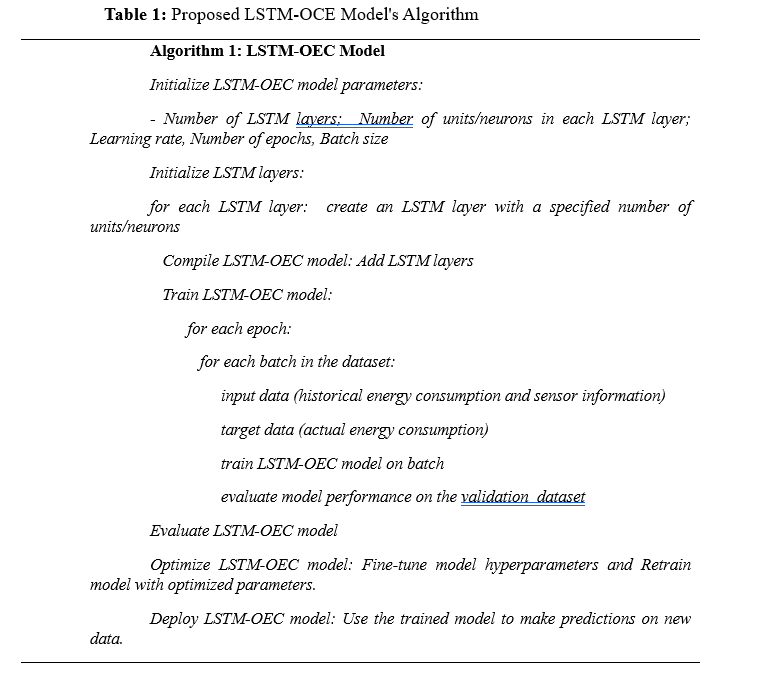
The sophisticated LSTM-OEC model uses LSTM networks to handle smart building energy optimization challenges. The model captures temporal dependencies in energy consumption statistics and real-time sensor information to provide a sophisticated understanding of energy usage components' dynamic interactions. The LSTM-OEC paradigm enables proactive, data-driven decision-making for smart buildings' sustainable and efficient operation through dynamic optimization. The approach allows building control systems to make real-time modifications to optimize energy usage, occupant comfort, and environmental sustainability using predicted insights from historical and real-time data. The LSTM-OEC model transforms smart building energy management by seamlessly integrating powerful machine-learning techniques with real-world applications. The methodology enables sustainable and resilient smart building ecosystems by solving energy optimization's numerous difficulties holistically.
4. Results and Discussion
a. Setup
The study employed an extensive dataset of historical energy consumption data and real-time sensor information from smart buildings [29] in the experimental configuration. The dataset encompasses a range of factors, including HVAC utilization, lighting intensity, occupancy trends, temperature, humidity, and exterior meteorological conditions. The dataset was partitioned into three subsets: training (60%), validation (20%), and testing (20%), in order to ensure a comprehensive assessment of the model. The performance of the suggested LSTM-OEC model was assessed using a variety of assessment measures, including the R-squared coefficient, Mean Squared Error (MSE), Root Mean Squared Error (RMSE), Mean Absolute Percentage Error (MAPE), and Peak Load Reduction rate. These data offer a thorough understanding of the models' forecast accuracy, error rates, and energy optimization capabilities. Furthermore, the study compared the LSTM-OEC model's performance to various other models, such as Random Forest (RF), K-nearest Neighbors (KNN), and SVM. The selection of these models was based on their pertinence to tasks involving the forecast of energy use and their extensive utilization in the existing body of literature. Using this experimental configuration, the objective was to comprehensively examine the efficacy of the LSTM-OEC model in optimizing energy usage in smart buildings compared to pre-existing models.
b. Results
Figure 2 depicts the R-squared coefficient values for the LSTM-OEC model and other models, specifically RF, KNN, and SVM, at various epoch counts. The R-squared coefficient values indicate the extent to which the models explain the variance in the energy consumption data, with larger values suggesting superior prediction accuracy. After careful examination, it is clear that the LSTM-OEC framework continuously surpasses the existing algorithms in performance throughout all epochs. The LSTM-OEC model performs better than RF, KNN, and SVM, with an R-squared coefficient of 89.15% after 20 epochs. With increasing epochs, the LSTM-OEC model demonstrates greater superiority, as evidenced by its R-squared values reaching 97.89% at 100 epochs, which is the greatest among all models. The outstanding success of the LSTM-OEC model can be attributed to its ability to accurately capture complex temporal relationships and adapt to changing energy consumption patterns in intelligent buildings. The recurrent design of the LSTM-OEC model facilitates their ability to effectively acquire knowledge from sequential data, leading to enhanced predicted accuracy and improved exploitation of real-time sensor information.
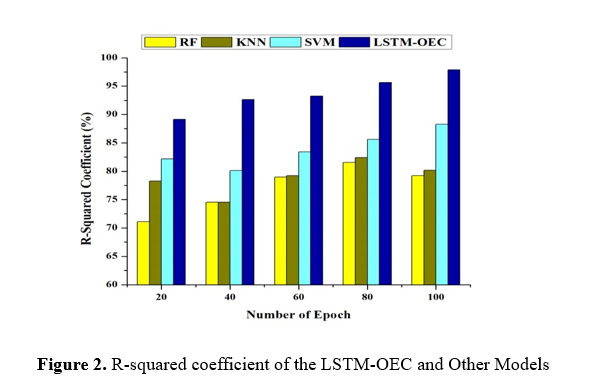
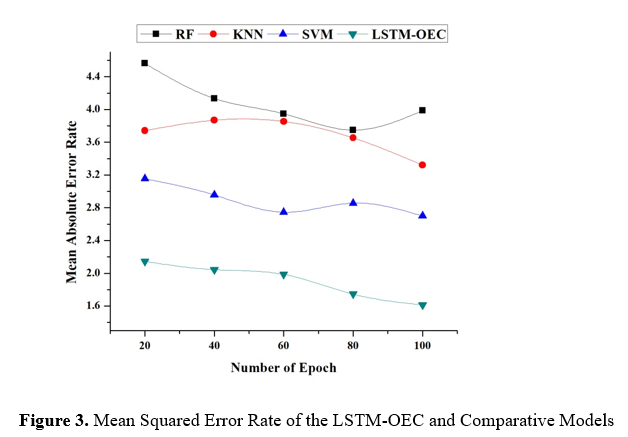
Figure 3 displays the MSE rates for the LSTM-OEC model and its comparator models, namely RF, KNN, and SVM, across several epochs. The MSE rate is a metric that measures the average squared deviation between projected and actual energy consumption figures. Decreased values of the MSE rate indicate higher levels of predictive accuracy. After careful examination, it is clear that the LSTM-OEC model continuously surpasses the other models in terms of MSE rates over all epochs. The LSTM-OEC model performs better than RF, KNN, and SVM, achieving the lowest MSE rate of 2.145 after 20 epochs. The LSTM-OEC model has constantly improved performance as the number of epochs grows, continually demonstrating lower MSE rates than the other models. The remarkable effectiveness of the LSTM-OEC model can be attributed to its ability to accurately represent complex temporal relationships and adapt to changing patterns of energy use in smart buildings. The LSTM architecture facilitates the model's ability to efficiently acquire knowledge from sequential input, leading to enhanced predictive accuracy and improved management of energy use.
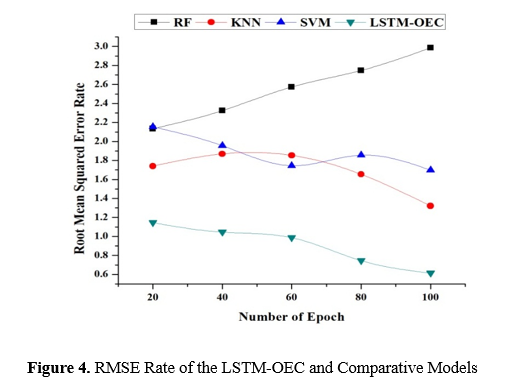
Figure 4 illustrates the RMSE rates for the LSTM-OEC model and its comparator models, namely RF, KNN, and SVM, across several epochs. The RMSE is a metric that measures the average squared deviation between projected and actual energy consumption numbers. A lower RMSE value signifies a higher level of prediction accuracy. After careful examination, it is clear that the LSTM-OEC model continuously surpasses the other algorithms in terms of RMSE rates over all epochs. The LSTM-OEC model performs better than RF, KNN, and SVM, with the lowest RMSE rate of 1.145 after 20 epochs. The LSTM-OEC model has consistently improved performance as the number of epochs grows, consistently demonstrating lower RMSE rates than the other models. The excellent success of the LSTM-OEC model can be attributed to its ability to effectively capture complex temporal relationships and adapt to dynamic patterns of energy usage in smart buildings. The model can efficiently learn from sequential data thanks to the LSTM architecture, which improves prediction accuracy and optimizes energy consumption.
Figure 5 illustrates the MAPE rates throughout several epochs for the LSTM-OEC model, as well as the other models presently employed, namely KNN, RF, and SVM. The MAPE is a quantitative measure that assesses the average percentage discrepancy between anticipated and actual usage of energy figures. An MAPE number that is lower indicates a higher level of prediction accuracy. Based on the conducted analysis, it is evident that the LSTM-OEC paradigm consistently demonstrates greater performance in terms of MAPE rates when compared to the current models. After 20 epochs, the LSTM-OEC model demonstrates the lowest MAPE rate of 1.987%, surpassing the performance of RF, KNN, and SVM. The LSTM-OEC model has constant higher performance as the number of epochs grows, consistently demonstrating lower MAPE rates than the other models. The tremendous efficacy of the LSTM-OEC model can be attributed to its ability to effectively capture complex temporal linkages and adapt to dynamic patterns of energy use in smart buildings. The LSTM architecture enables efficient knowledge acquisition from sequential data, enhancing predictive accuracy and improving energy usage management.
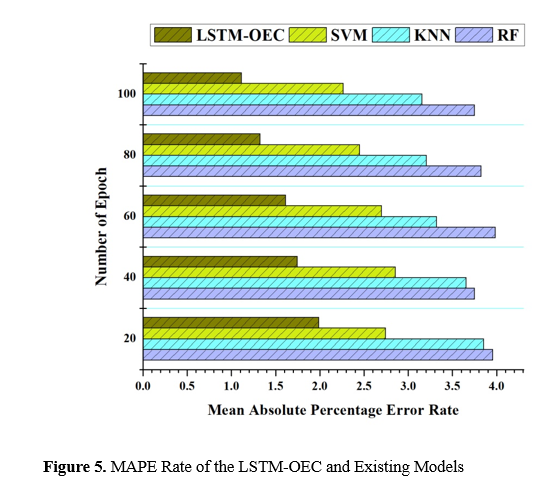
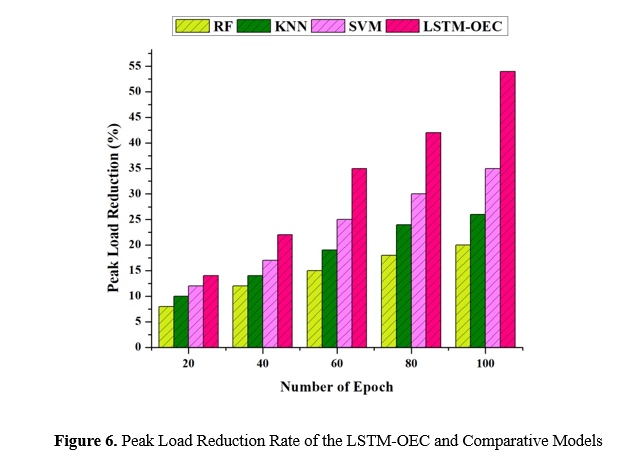
Figure 6 presents the PLR rates for the LSTM-OEC and comparator models, namely RF, KNN, and SVM, at different epochs. PLR is a metric used to evaluate the ability of models to reduce peak energy demand during periods of high demand. A higher rate of PLR indicates greater effectiveness in optimizing energy usage. It is evident from a thorough analysis that the LSTM-OEC system continuously outperforms the comparator systems in terms of PLR rates across all epochs. The LSTM-OEC model demonstrates a Peak Load Reduction rate of 14% after 20 epochs, outperforming the RF, KNN, and SVM models. The LSTM-OEC model demonstrates its superiority as the number of epochs increases, as evidenced by its PLR rates of 54% at 100 epochs, notably greater than the other models. Predictive insights enable the LSTM-OEC model to dynamically regulate energy usage and capture complex temporal correlations, which contributes to its excellent performance. The recurrent architecture of the system facilitates the efficient acquisition of knowledge from sequential data, leading to the development of proactive energy management methods that effectively mitigate peak energy demand and improve overall energy efficiency in smart buildings.
c. Discussion
The acquired results offer comprehensive insights into the LSTM-OEC model's performance in relation to other models across a range of measures. Figure 2 showcases the consistently improved performance of the LSTM-OEC model in terms of R-squared coefficient values. It indicates a higher level of predictive accuracy and a greater ability to capture a larger proportion of variance in the energy consumption data. The LSTM-OEC model's ability to capture intricate temporal relationships is responsible for its excellence in properly predicting energy demand in smart buildings. Figures 3 and 4 illustrate the higher performance of the LSTM-OEC model in terms of MSE and RMSE rates, respectively. Throughout all epochs, the LSTM-OEC model continually demonstrates superior accuracy in predicting energy consumption patterns since it consistently achieves lower error rates than comparison models. The improved accuracy of predictions and optimization of energy usage can be attributed to the LSTM-OEC model's capacity to adapt to changing energy consumption dynamics.
Moreover, as depicted in Figure 5, the LSTM-OEC model regularly demonstrates superior performance compared to existing models regarding MAPE rates. A lower MAPE rate indicates superior prediction accuracy, and the LSTM-OEC model demonstrates notably reduced error rates compared to alternative models over all epochs. It highlights the efficacy of the LSTM-OEC model in capturing intricate energy usage patterns and delivering more precise predictions. Finally, Figure 6 demonstrates that the LSTM-OEC model outperforms other Peak Load Reduction rates models throughout all epochs. The LSTM-OEC model demonstrates its capacity to dynamically optimize energy consumption and decrease peak energy demand during periods of high demand, thereby enhancing energy efficiency and promoting the sustainable operation of smart buildings. This study's findings confirm the LSTM-OEC model's effectiveness in enhancing smart buildings' energy efficiency, establishing it as a viable approach for promoting sustainable and effective building operations.
5. Conclusion
The primary goal of this study was to optimize energy usage in smart buildings by combining big data analytics and machine learning approaches. The introduction of the LSTM-OEC model aimed to incorporate historical energy consumption data and real-time sensor information from IoT devices to effectively regulate energy usage dynamically. The major intention of this study were to create a predictive energy management framework utilizing LSTM models, to analyze its effectiveness in managing energy usage, and to evaluate its scalability and utility in practical smart building situations. The present study has made a noteworthy contribution to the existing body of literature by introducing an innovative methodology for energy optimization utilizing LSTM networks. The study's results highlight the LSTM-OEC model's higher performance compared to traditional forecasting approaches and comparative models such as RF, KNN, and SVM. This superiority is evident across multiple evaluation measures, including the R2 coefficient, MSE, RMSE, MAPE, and PLR rate. This study's results have demonstrated the LSTM-OEC model's effectiveness in properly forecasting energy consumption trends and maximizing energy utilization in intelligent buildings. Nevertheless, it is crucial to recognize certain constraints, such as the dependence on simulated or restricted real-world datasets that may not comprehensively encompass the intricacies of varied building settings. Furthermore, the suggested LSTM-OEC model may want additional refinement and verification in extensive implementations to guarantee its resilience and efficacy in real-world scenarios. Potential future endeavours may involve broadening the room of study to encompass a wider variety of datasets derived from authentic smart building environments, engaging in collaborative efforts with industry partners to validate findings in real-world deployment situations, and investigating sophisticated machine learning methodologies to enhance predictive capabilities. Additionally, the incorporation of additional factors such as occupancy patterns and data from building energy management systems may yield a deeper comprehension of utilization dynamics and enhance the effectiveness of energy optimization strategies. This study establishes a fundamental basis for forthcoming investigations focused on the progression of sustainable and efficient building operations by means of data-driven energy management methodologies.
References :
[1]. Mishra, P., & Singh, G. (2023). Energy management systems in sustainable smart cities based on the internet of energy: A technical review. Energies, 16(19), 6903
[2]. Kuthadi, V. M., Selvaraj, R., Baskar, S., & Shakeel, P. M. (2022). Data security tolerance and portable based energy-efficient framework in sensor networks for smart grid environments. Sustainable Energy Technologies and Assessments, 52, 102184.
[3]. Umoh, A. A., Nwasike, C. N., Tula, O. A., Adekoya, O. O., & Gidiagba, J. O. (2024). A ReviewoOf Smart Green Building Technologies: Investigating the Integration and Impact of AI and IoT In Sustainable Building Designs. Computer Science & IT Research Journal, 5(1), 141-165.
[4]. Verdecchia, R., Lago, P., & De Vries, C. (2022). The future of sustainable digital infrastructures: A landscape of solutions, adoption factors, impediments, open problems, and scenarios. Sustainable Computing: Informatics and Systems, 35, 100767.
[5]. Shiri, F. M., Perumal, T., Mustapha, N., & Mohamed, R. (2023). A comprehensive overview and comparative analysis on deep learning models: CNN, RNN, LSTM, GRU. arXiv preprint arXiv:2305.17473.
[6]. Orikpete, O. F., Ikemba, S., & Ewim, D. R. E. (2023). Integration of Renewable Energy Technologies in Smart Building Design for Enhanced Energy Efficiency and Self-Sufficiency. The Journal of Engineering and Exact Sciences, 9(9), 16423-01e.
[7]. Orikpete, O. F., Ikemba, S., & Ewim, D. R. E. (2023). Integration of Renewable Energy Technologies in Smart Building Design for Enhanced Energy Efficiency and Self-Sufficiency. The Journal of Engineering and Exact Sciences, 9(9), 16423-01e.
[8]. Alanne, K., & Sierla, S. (2022). An overview of machine learning applications for smart buildings. Sustainable Cities and Society, 76, 103445.
[9]. Sierla, S., Pourakbari-Kasmaei, M., & Vyatkin, V. (2022). A taxonomy of machine learning applications for virtual power plants and home/building energy management systems. Automation in Construction, 136, 104174.
[10]. Shah, S. F. A., Iqbal, M., Aziz, Z., Rana, T. A., Khalid, A., Cheah, Y. N., & Arif, M. (2022). The role of machine learning and the internet of things in smart buildings for energy efficiency. Applied Sciences, 12(15), 7882.
[11]. Alzoubi, A. (2022). Machine learning for intelligent energy consumption in smart homes. International Journal of Computations, Information and Manufacturing (IJCIM), 2(1).
[12]. Ardabili, S., Abdolalizadeh, L., Mako, C., Torok, B., & Mosavi, A. (2022). Systematic review of deep learning and machine learning for building energy. Frontiers in Energy Research, 10, 786027.
[13]. Hassan, M., Kanwal, A., Jarrah, M., Pradhan, M., Hussain, A., & Mago, B. (2022, February). Smart City Intelligent Traffic Control for Connected Road Junction Congestion Awareness with Deep Extreme Learning Machine. In 2022 International Conference on Business Analytics for Technology and Security (ICBATS) (pp. 1-4). IEEE.
[14]. Aliero, M. S., Asif, M., Ghani, I., Pasha, M. F., & Jeong, S. R. (2022). Systematic review analysis on smart building: Challenges and opportunities. Sustainability, 14(5), 3009.
[15]. Mazhar, T., Irfan, H. M., Haq, I., Ullah, I., Ashraf, M., Shloul, T. A., ... & Elkamchouchi, D. H. (2023). Analysis of challenges and solutions of IoT in smart grids using AI and machine learning techniques: A review. Electronics, 12(1), 242.
[16]. Olu-Ajayi, R., Alaka, H., Sulaimon, I., Sunmola, F., & Ajayi, S. (2022). Building energy consumption prediction for residential buildings using deep learning and other machine learning techniques. Journal of Building Engineering, 45, 103406.
[17]. Raza, A., Jingzhao, L., Ghadi, Y., Adnan, M., & Ali, M. (2024). Smart home energy management systems: Research challenges and survey. Alexandria Engineering Journal, 92, 117-170.
[18]. Mostafa, N., Ramadan, H. S. M., & Elfarouk, O. (2022). Renewable energy management in smart grids by using big data analytics and machine learning. Machine Learning with Applications, 9, 100363.
[19]. Forootani, A., Rastegar, M., & Jooshaki, M. (2022). An advanced satisfaction-based home energy management system using deep reinforcement learning. IEEE Access, 10, 47896-47905.
[20]. Huotari, M., Malhi, A., & Främling, K. (2024). Machine Learning Applications for Smart Building Energy Utilization: A Survey. Archives of Computational Methods in Engineering, 1-20.
[21]. Pramanik, A. S., Sepasi, S., Nguyen, T. L., & Roose, L. (2024). An ensemble-based approach for short-term load forecasting for buildings with high proportion of renewable energy sources. Energy and Buildings, 113996.
[22]. Lin, M., Peng, L., Liu, T., & Zhang, L. (2024). Novel approach to energy consumption estimation in smart homes: application of data mining and optimization techniques. Frontiers in Energy Research, 12, 1361803.
[23]. Borda, D., Bergagio, M., Amerio, M., Masoero, M. C., Borchiellini, R., & Papurello, D. (2023). Development of anomaly detectors for HVAC systems using machine learning. Processes, 11(2), 535.
[24]. Toosi, H. A., Del Pero, C., Leonforte, F., Lavagna, M., & Aste, N. (2023). Machine learning for performance prediction in smart buildings: Photovoltaic self-consumption and life cycle cost optimization. Applied Energy, 334, 120648.
[25]. Śmiałkowski, T., & Czyżewski, A. (2023). Autoencoder application for anomaly detection in power consumption of lighting systems. IEEE Access.
[26]. Salazar, E. J., Jurado, M., & Samper, M. E. (2023). Reinforcement learning-based pricing and incentive strategy for demand response in smart grids. Energies, 16(3), 1466.
[27]. Hakimazari, M., Baghoolizadeh, M., Sajadi, S. M., Kheiri, P., Moghaddam, M. Y., Rostamzadeh-Renani, M., ... & Hamooleh, M. B. (2024). Multi-objective optimization of daylight illuminance indicators and energy usage intensity for office space in Tehran by genetic algorithm. Energy Reports, 11, 3283-3306.
[28]. Khan, S. U., Khan, N., Ullah, F. U. M., Kim, M. J., Lee, M. Y., & Baik, S. W. (2023). Towards intelligent building energy management: AI-based framework for power consumption and generation forecasting. Energy and buildings, 279, 112705
[29]. Hatamian, M., Panigrahi, B., & Dehury, C. K. (2023). Location-aware green energy availability forecasting for multiple time frames in smart buildings: The case of Estonia. Measurement: Sensors, 25, 100644.
[30]. https://www.kaggle.com/datasets/claytonmiller/cubems-smart-building-energy-and-iaq-data?select=2018Floor1.csv